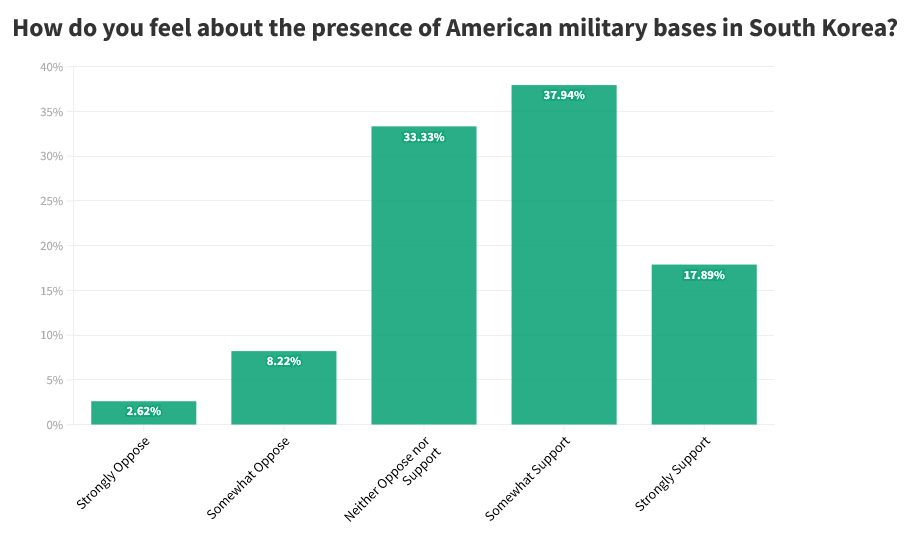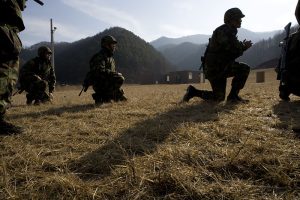Conventional wisdom suggests that, outside of high-profile scandals such as rape cases, the South Korean public remains generally positive about the U.S. military presence. This is despite tensions in recent years about the costs of hosting U.S. troops. For example, in 2020, the Trump administration demanded a fivefold increase in South Korea’s payments for U.S. military costs, rejecting a 14 percent increase proposed by the Moon administration. The Biden administration ultimately agreed on a six-year extension with increases over time.
However, little attention has been to paid to what the South Korean public sees as a fair cost-sharing arrangement, and how this corresponds with overall evaluations of the U.S. presence.
Identifying exactly how much South Korea contributes toward the total cost of the U.S. presence is complicated and can vary based on the estimated value of land use, among other factors, with most estimates of South Korea’s commitment ranging from about 30 percent to 44 percent. Similarly, most South Koreans are unlikely to know their country’s actual contribution level but rather estimate what is acceptable based on perceived benefits and recent issues in South Korea-U.S. relations.
The importance of the South Korea-U.S. alliance can be seen with the united response condemning North Korea’s numerous missile tests this year, including its first IBCM test since 2017. The U.S. military presence in South Korea and Japan provides regional stability, with embassy officials in Seoul expressing that the presence deters regional adversaries. If so, the South Korean public, unsure of their own military’s deterrent capabilities, may see a U.S. presence as crucial to maintaining peace. But what cost are they willing to pay to preserve that presence?
To address South Korean public perceptions of the U.S. military, we conducted a national web survey of 1,107 respondents in South Korea from March 11-16, 2022, administered by Macromill Embrain and using quota sampling for age, gender, and geographic region.
We first asked: “On a scale of 1 to 5, with 1 being strongly opposed and 5 being strongly support, how do you feel about the presence of American military bases in South Korea?” We found that a majority of respondents state that they somewhat or strongly support the presence (55.83 percent) compared to only 10.84 percent stating they somewhat or strongly oppose, rates that suggest the public generally sees the presence as an effective and perhaps cost-effective deterrent to North Korean aggression. A third of respondents expressed a neutral position.

We also asked, “From 0 percent to 100 percent, what percentage of the costs of the U.S. military presence in South Korea do you believe South Korea should pay?” The average response was 32.08 percent, below estimates of what South Korea currently pays.
Broken down by political party identification, we find supporters of the main conservative party, the People Power Party (PPP), overwhelmingly in favor of the U.S. presence (74.02 percent) with only 2.85 percent opposed. In contrast, a plurality of supporters of the main liberal party, the Democratic Party (DP), supported the U.S. presence (49.41 percent), with 17.8 percent in opposition.
When shifting to cost-sharing, PPP supporters on average supported a higher contribution (35.62 percent) than the DP supporters (31.19 percent). Even the higher amount, however, is below most estimates of South Korea’s current contribution level. The results suggest that President-elect Yoon Suk-yeol’s base, although supportive of the U.S. presence and likely supportive of Yoon’s desire to strengthen relations between the two countries, are unlikely to support higher cost shares.
We assumed that support for the U.S. presence would positively correspond to a willingness to shoulder higher costs. As shown in the figure below, this pattern is very clear, from an average of 9.26 percent cost-sharing among those strongly opposed to the presence to 42.40 percent for those strongly supportive. These findings suggest that the current high-end estimates of about 44 percent may be the best that South Korean administrations can offer without risking a public backlash.

Respondents were also asked, “In general, do you believe that the U.S. shares the same concerns as South Korea over North Korea?” Here we find that 56.55 percent of respondents say yes, and that those respondents indicate, on average, that South Korea should pay more (34.28 percent vs. 30.88 percent among those responding no). Again, we find PPP supporters slightly more likely to say yes (60.85 percent) compared to DP supporters (56.91 percent).
Admittedly, national security decisions such as alliances are not dependent on public approval, but broad public support in South Korea for the U.S. military presence certainly simplifies the decision. Our findings suggest the South Korean public will be receptive to Yoon’s intention to strengthen South Korea-U.S. security ties, especially as North Korea continues to hone its missile and nuclear capabilities.
Thinking long term, maintaining mutual satisfaction in the South Korea-U.S. alliance requires the continued identification of shared security goals and an awareness of potential sensitivities to cost-sharing arrangements. Yoon will benefit from not having to renegotiate cost-sharing arrangements, but his administration may wish to find ways to emphasize the value of the relationship to maintain public support for rising costs, perhaps focusing on gradual increases and other trust-building measures.

































